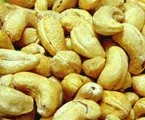
Delicately sweet yet crunchy and delicious cashew nut is packed with energy, antioxidants, minerals and vitamins that are essential for robust health. Cashew, or “caju” in Portuguese, is one of the popular ingredients in sweet as well savory dishes worldwide. Botanically, cashew is an average sized tropical evergreen tree belonging to the Anacardiaceae family, in the genus: Anacardium. Scientific name: Anacardiumoccidentale.
The cashew tree is native to Brazil’s Amazon rain forest. It spread all over the planet by Portuguese explorers and today, it is cultivated at commercial scale in Brazil, Vietnam, India and in many African countries.
 Cashew tree bears numerous, edible, pear shaped false fruits or “accessory fruits’” called “cashew apples.” Cashew nut which actually is a “true-fruit”, firmly attaching to bottom end of cashew-apple, appearing like a clapper in the bell. Botanically, this tiny, bean shaped, grey “true fruit” is a drupe, featuring hard outer shell enclosing a single edible kernel known commercially as “cashew nut.”
Cashew tree bears numerous, edible, pear shaped false fruits or “accessory fruits’” called “cashew apples.” Cashew nut which actually is a “true-fruit”, firmly attaching to bottom end of cashew-apple, appearing like a clapper in the bell. Botanically, this tiny, bean shaped, grey “true fruit” is a drupe, featuring hard outer shell enclosing a single edible kernel known commercially as “cashew nut.”
Its exterior shell composes a phenolic resin, urushiol, which is a potent caustic skin irritant toxin. In the processing units, this outer shell is roasted under high flame in order to destroy urushiol resin, and only then underlying edible cashew kernel is extracted. Cashew nut measures about an inch in length, 1/2 inches in diameter, and kidney or bean shape, with smooth curvy pointed tip. Each nut splits into two equal halves as in legumes. Cashews featurec ream white color with the firm yet delicate texture and smooth surface.
Etymology
Its English name derives from the Portuguese name for the fruit of the cashew tree caju (Portuguese pronunciation: [kaˈʒu]), which itself is derived from the Tupian word acajú, literally meaning “nut that produces itself”. The name Anacardium, originally from the Greek, refers to the unusual location of the seed outside the core or heart of the fruit (ana- means “again” or “backward” and -cardium means “heart”).
Cashew “nut” and shell
 Culinary uses for cashew seeds in snacking and cooking are similar to those for all tree seeds called nuts. Cashew nuts are commonly used in Indian cuisine, whole for garnishing sweets or curries, or ground into a paste that forms a base of sauces for curries (e.g., korma), or some sweets (e.g., kajubarfi). It is also used in powdered form in the preparation of several Indian sweets and desserts.
Culinary uses for cashew seeds in snacking and cooking are similar to those for all tree seeds called nuts. Cashew nuts are commonly used in Indian cuisine, whole for garnishing sweets or curries, or ground into a paste that forms a base of sauces for curries (e.g., korma), or some sweets (e.g., kajubarfi). It is also used in powdered form in the preparation of several Indian sweets and desserts.
In Goan cuisine, both roasted and raw kernels are used whole for making curries and sweets. Cashew nuts are also used in Thai and Chinese cuisine, generally in whole form. In the Philippines, cashew is a known product of Antipolo, and is eaten with suman. Pampanga also has a sweet dessert called turrones de casuy, which is cashew marzipan wrapped in white wafers. In Indonesia, roasted and salted cashew nut is called kacangmete or kacangmede, while the cashew apple is called jambumonyet (translates in English to monkey rose apple).
 In Mozambique, bolo polana is a cake prepared using powdered cashews and mashed potatoes as the main ingredients. This dessert is popular in South Africa In Brazil, the cashew fruit juice is popular. In Panama, the cashew fruit is cooked with water and sugar for a prolonged time to make a sweet, brown, paste-like dessert called dulce de marañón, with marañón as a Spanish name for cashew. In the 21st Century, cashew cultivation increased in several African countries to meet the demands for manufacturing cashew milk, a plant milk alternative to dairy milk.
In Mozambique, bolo polana is a cake prepared using powdered cashews and mashed potatoes as the main ingredients. This dessert is popular in South Africa In Brazil, the cashew fruit juice is popular. In Panama, the cashew fruit is cooked with water and sugar for a prolonged time to make a sweet, brown, paste-like dessert called dulce de marañón, with marañón as a Spanish name for cashew. In the 21st Century, cashew cultivation increased in several African countries to meet the demands for manufacturing cashew milk, a plant milk alternative to dairy milk.
The shell of the cashew nut contains oil com pounds which may cause contact dermatitis similar in severity to that of poison ivy, primarily resulting from the phenolic lipids, anacardic acid and cardanol.Due to the possible dermatitis, cashews are typically not sold in the shell to consumers.Readily and inexpensively extracted from the waste shells, cardanol is under research for its potential applications in nanomaterials and biotechnology.
